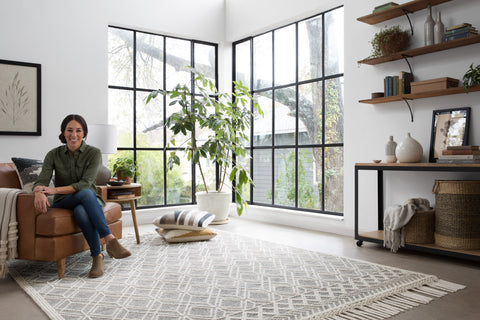- Continue Shopping
- Your Cart is Empty
Joanna Gaines Magnolia Home

Joanna Gaines does it all. Co-host and rockstar interior designer of HGTV's Fixer-Upper and design mind behind the interior design brand, Magnolia Homes, the taste-making Texan brings her magical touch to this collection of area rugs by Loloi.
True to her signature style, these power-loomed, hand-woven, and tufted rugs combine classic motifs with tones and finishes to create spaces that are as elegant as they are cozy. You'll find neutral tones like ivory, bone, taupe, spice, and marine, as well as more contemporary area rugs in charcoal, sand, and denim.
The Magnolia Rug collection features an array of sizes and price points, offering affordable area rugs for any budget and room size. Some collections have round rugs and runners perfect for hallways and entryways.
No products found in this collection.
Frequently Asked Questions
The good news is that with hand-made rugs like ours, cleaning and repair is almost always possible. In day-to-day care, vacuuming is good for the rug — but be sure to vacuum without the beater bar. When an accident does happen (like food or dirt), blot it quickly — never, ever scrub a stain! However, when an epic stain occurs (e.g. red wine on white wool or silk), we recommend sending it for a professional cleaning after initial blotting and cleaning with mild soap: try not to let stains dry and set. If you think you need a professional cleaning, contact us for an appraisal at concierge@floorplanrugs.com.
Hand-made rugs have a long life; they even can last centuries. They will wear beautifully over time, with the colors changing with age and sunlight (think of it as aging like a fine wine). Hand-woven rugs are typically thinner than hand-knotted, but one can still expect to spend many decades with a good quality woven piece. Do not expect the same longevity from machine-made or rugs with rubber or glue backings; these typically hold up for only a few years.
There is no commodities exchange to determine the value of a carpet. There are many factors that influence their price: age, individuality, complexity of design, quality of material, density of weave, origin and size. A good rule is to budget for the rug the way one would for a central piece of furniture, like a dining table or couch. It’s exposed to an incredible amount of wear and tear, and a higher quality will make a marked difference in both the lifetime of the rug and the interest it adds to the room.
We work hard to insure that our suppliers do not use child labor. For vintage pieces (older than 40 years), it is not possible to confirm where or by whom they were made. In many villages where women weave tribal rugs in the home, it is common for the entire family to be involved in some aspects of weaving, much the same way our kids might mow the lawn or help with chores. Needless to say, we buy direct from the source, and if we become aware of child labor in workshops, we stop working with those facilities.
Since we are committed to quality hand-made rugs, we stock rugs with natural fibers like wool, silk, cotton, jute and sisal. They last longer than synthetic materials like polyester, acrylics, and nylon are easier to clean and repair. Most of our rugs will have a cotton foundation and a wool pile. Synthetic materials (polyester, polypropylene, etc.) can also be used to produce rugs, but they are not as durable and cannot be cleaned or repaired as easily as natural fibers. For these reasons, we avoid rugs with these materials.









